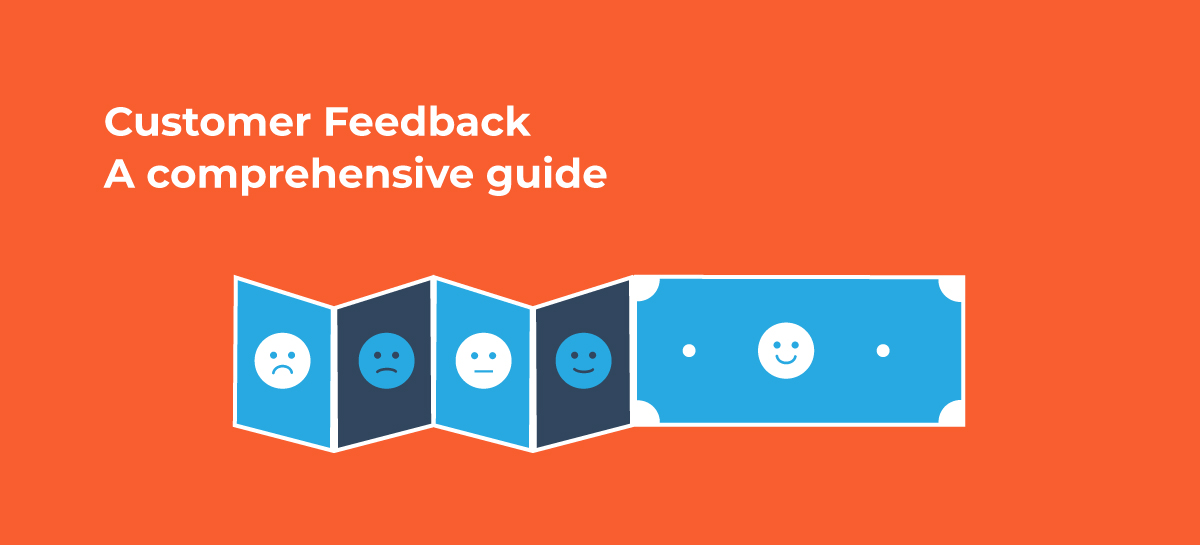
Customer feedback: whether you are afraid of it or want to use it to understand what your customers want and how to give it to them, this guide is the perfect starting point.
So keep reading or use the table of contents to go straight to the section that most interests you.
1. What is Customer Feedback?
Customer feedback is essentially what every brand/organization needs in order to achieve the best possible customer satisfaction level.
It is the information customers provide about their experience with a product or a service and can be collected through several tools, using different methods and metrics, on different moments during the customers’ journey. Customer feedback also includes any general experience they’ve had with a company.
The purpose of collecting customer feedback is to reveal the customers’ level of satisfaction and provide useful insights for the product, customer success, sales and marketing teams as there is always room for improvement and innovation.
But it doesn’t end there. Brands and companies that systematically activate customer feedback procedures are those who achieve better customer engagement. In fact, customer engagement is further enhanced when closing the loop campaigns are also part of the customer feedback journey.
The process of collecting customer feedback is itself a first step towards communicating to customers that a brand is interested in hearing their opinion, a step that indicates professionalism and an intention for customer-centricity.
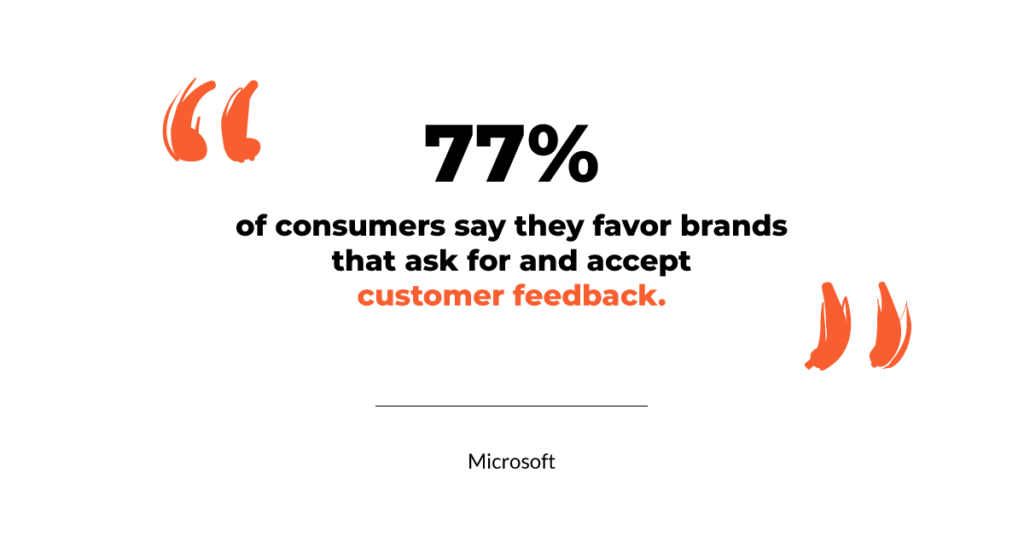
Information is as good as gold when a brand seeks to forge a strong bond with its audience. If we do not know what resonates and what does not sit well with our customers -thus not taking any action- failure is around the corner. The least we can do is to not be afraid to learn what customers have to say and how they feel about their experiences.
2. What are the different types of Customer Feedback?
As stated before, listening to your customers when they give you feedback is one of the most important things an organization can do to improve their customer retention and build brand loyalty.
More specifically, customer feedback comes in three forms. Not all of them require the brand/organization to take action in order to initiate communication with its audience, but on all three cases the information provided by customers should not be ignored:
A. Given Customer Feedback
B. Requested Customer Feedback
C. Observed Customer Feedback
Let’s focus on each of them:
A. Given Customer Feedback
A lot of times it’s the customers that decide to share their experience on their own. That is the reason why brands should establish various touchpoints that cover that need and satisfy their customers’ initiative. Furthermore, contact information should be visible, easy to find and interactive (e.g. customer requests and comments must never be left unanswered -even an automated message that thanks customers for getting in touch with you can make a big difference).
Here is a list of customer touchpoints:
-
- Call Center
- Social Media
- Website Bots
- Emails
Any comments obtained via those touchpoints need to be answered, recorded and be used as pieces of information that can be analyzed and processed in a way that leads to the formulation of useful insights that will dictate the optimal courses of action.
B. Requested Customer Feedback
This is the type of feedback offered by customers when asked by a brand. Requested customer feedback can be obtained through the following methods:
-
- CX surveys (using metrics like CSAT, NPS, CES)
- Replies to email newsletters
- Onboarding feedback
- Customer reviews
- Product reviews
- Feedback from support conversations
- In-person interviews or focus groups
Each of the aforementioned methods needs specialized tools and the help of experts in order to be successfully implemented and allow for feedback collection and most advantageous capitalization on the answers provided.
This is most true when applied to customer feedback surveys that use metrics. The insights and experience of an expert can prove crucial in these cases since metrics are slightly tricky and may create a number of questions, such as when is the right time to ask questions and what kind of questions should be used each time. Metric analysis and insight extraction also require a thorough understanding of the whole process and getting customers to respond and also believe that their feedback is valued takes a carefully mapped-out approach.
Another element related to requested customer feedback is the set of rules pertaining to the type and frequency of initiated customer contact. A general rule is to try to keep communication pleasant and ensure that customers understand that it’s important, not just for you but also for them, to provide their answers.
C. Observed Customer Feedback
Before the advent of online shopping, it was common practice for retailers to observe customers at physical stores. How did they move around, what drew their attention, what type of personality did they seem to possess?
This type of observation has not ceased on the digital age, it has rather been adapted to fit the current state of consumerism. These observations still provide important intel and -when combined with targeted advertising- can draw impressive results.
The sources and tools of observation are numerous and new keep popping up. The most common are:
-
- Social media remarketing
- Cookies
- Popular features
- Website conversion points
- User experience design
The real challenge is for brands and organizations to find ways to combine different feedback types and maintain a steady line of communication with their customers while simultaneously trying to satisfy their requests and creating growth opportunities using the insights inherent to any form of feedback.
3. Why is Customer Feedback Important?
To suggest that asking and collection customer feedback is beneficial for companies and brands is an understatement. The potential hidden behind what customers think of a product or service cannot be stressed enough. If we were to sum up the benefits of customer feedback, three would prove to be the most significant:
- Customer Feedback helps you improve Customer Experience
- Customer Feedback helps you improve your product/service
- Customer Feedback shows you how engaged and loyal your customers are
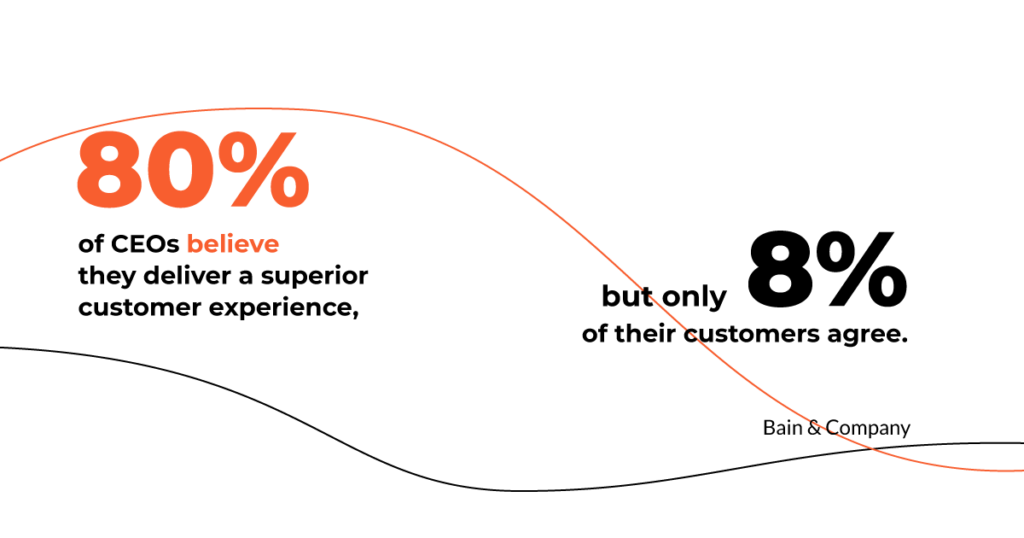
Mind the huge gap…
It is highly possible that a company may think it does its best to satisfy customers but -still- fall short on that domain.
The solution does not lie in the number of actions to be taken, but in their quality: first, you need to collect the feedback and then plan what is needed to be done to improve satisfaction and turn negative or neutral experiences into positive ones. Keep in mind that customers are the ones that determine whether a brand’s activation is valid in terms of enhancing their satisfaction or not.
As it has been already mentioned, feedback, when it stands on its own, is not effective. Its importance is revealed when it is translated to useful insights that take different forms and concern several domains, such as:
-
- Understanding of customers: what concerns them, what they favour and what they don’t like.
- Bottleneck detection: evaluate their gravity and find solutions.
- Customer engagement: what would make them happier and -eventually- loyal?
- Product improvement: use feedback to generate innovative ideas.
- Testimonials, reviews, referrals: social proof that builds brand trust and empowers customers
So, one way to gauge the significance of customer feedback is to think of it as the best way to discover a company’s performance in terms of customers’ satisfaction and as a source of the information essential towards achieving customer loyalty.
And if you’re wondering why a brand should aim for customer loyalty, here are some hard facts that showcase why loyalty through good customer experience is a key to growth:
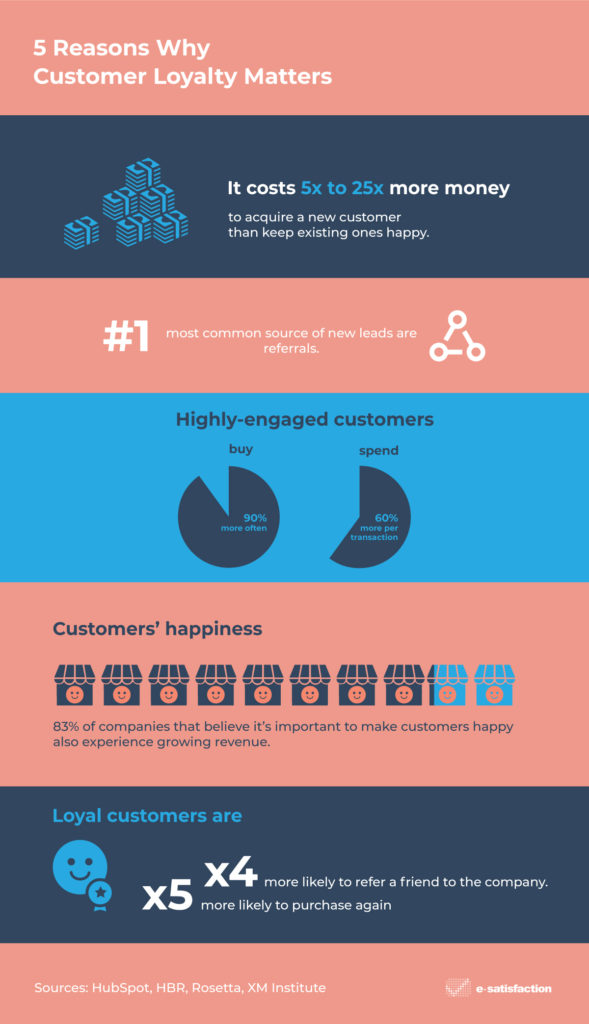
Another way of looking at customer feedback is through its social proof potential. Audiences are often not entirely convinced or even distrustful of the information that is being communicated via advertising and they naturally turn to other sources that will guide them when they decide what to purchase and what to avoid.
Customer feedback, in its social proof forms (e.g. testimonials, product reviews), can serve as a means for brands to build trust. An impressing majority of people trust online reviews as much as the opinion of their friends. Social proof plays on our inherent desire to fit in, so it’s no wonder that its influence on customers’ decision-making has been growing tremendously and should not be underestimated.
4. How do you create a Customer Feedback Loop?
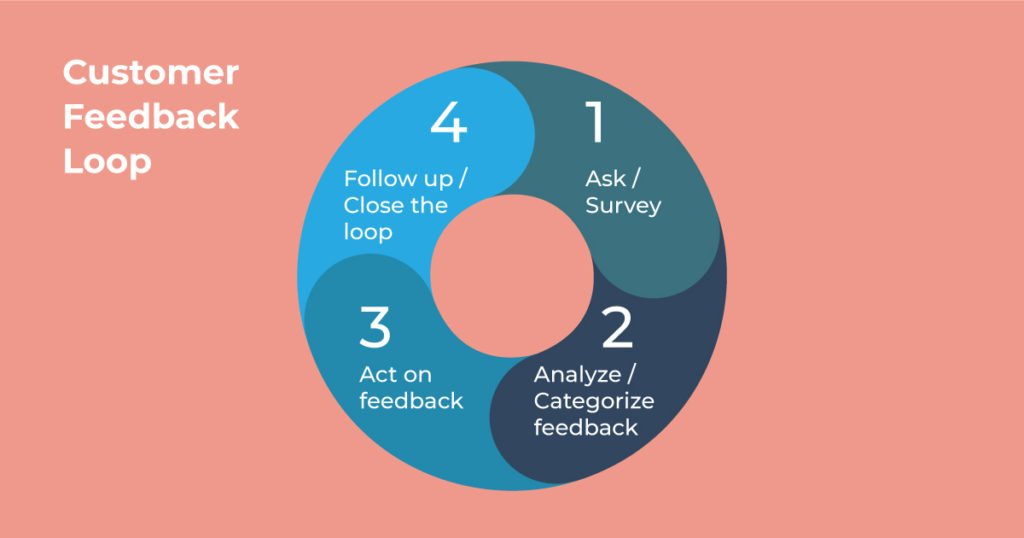
Collecting and using customer feedback is not a straight-line process, but one that works more effectively as a loop, as demonstrated.
The loop is divided into four stages:
Stage 1: Ask/Survey
Stage 2: Analyze/Categorize feedback
Stage 3: Act on feedback
Stage 4: Follow up/Close the loop
Let’s explore each one in more detail:
Stage 1: Ask/Survey
The trigger that activates the loop is a customer’s action. Most times, this action is a purchase completion, but the loop can also be activated after he/she made contact via your call centre or after the return of a product.
The first step, after a customer’s action, is to ask them to describe their experience. This is the survey stage of the loop, where specific metrics and open-end questions are incorporated to help put you in your customers’ shoes. The content and form of the questions should be created based on the survey’s objective and the subsequent use of the collected data. Another important factor that shapes a survey’s content is the nature and timing of the customer’s action. Different customer experiences (check out, product delivery, first contact with a product) call for different questions. Questions can also refer to other aspects of the customer journey, such as website functionality, evaluation of the delivery process, review of purchased product etc). Open-end questions come especially handy when more details are needed to fully gauge a customer’s experience.
As for the main metrics of the survey stage, they are presented below and analyzed in their dedicated section:
-
- NPS (Net Promoter Score)
- CSAT (Customer Satisfaction Score)
- CES (Customer Effort Score)
Stage 2: Analyze/Categorize Feedback
When data collection is over, it’s time for the truth to shine! But how can these individual pieces of information be translated into learnings that will paint the big picture of your brand’s level of customer satisfaction?
This is where discipline and rules come into play to help you detect and extract the information that will benefit you: areas in need of improvement, your brand’s strong points and USPs as well as opportunities for customer engagement and retention.
Metrics like CSAT and NPS makes everything easier since they are characterized by specific calculation and interpretation methods, which further allow you to categorize your customers into three types:
-
- Promoters
- Passives
- Detractors
This audience categorization may seem a little broad at first sight, but it is effective when used to plan and execute dedicated campaigns on the next stages until you end up closing the customer feedback loop. Even at the start of analyzing the attributes of each type, a brand can get a pretty clear picture of where it succeeds and where it falls short and generate ideas that will turn a detractor or a passive into an avid promoter.
This second stage is extremely crucial for the two that follow and for the ways a brand will capitalize on customer feedback. And that is the reason why attention should be paid on the choice of tools that collect and measure feedback. A tool whose features offer a comprehensive approach of the two first steps of the customer feedback loop and allows brands to continuously monitor results can make a big difference in the overall process and expected outcomes.
Stage 3: Act on feedback
Feedback status: collected and categorized! It’s time for distribution to the various departments and… action! All persons involved should have access to the obtained information and gain a thorough understanding of customer opinion. Keeping your feedback from them will never lead to generating new ideas, improving products/services, prioritizing your actions, recognizing pros and cons or predicting audience reaction to a change in their experience.
Despite the importance of this stage, this is where things usually go sour for brands and companies. Feedback distribution should be streamlined and this is where tools that offer ready-to-use and customizable dashboards and marketing automation platforms can help, especially when paired with a strong Customer Success team.
The frequency of feedback distribution to various team members varies, from real-time distribution (e.g. through alerts) to a weekly or monthly report that includes all necessary information. This information will also form the basis of the fourth and final stage of the Customer Feedback loop.
Stage 4: Follow up/Close the loop
People respond to customer satisfaction surveys because it is important for them to make their voice heard and see if a brand or company will value and use their feedback, in a direct or indirect fashion.
This intention on the part of the customers is the prerequisite for the existence of any sort of feedback. And the least that brands can do is to express their gratitude and appreciation to any customer who spares some minutes of his/her time to describe and share their experience.
Closing the loop is the step that will determine customers’ overall experience with a brand’s survey. Ignoring respondents is detrimental since it makes you look like you don’t value their trust and this will naturally influence their opinion and attitude towards your brand.
That being said, a customer feedback loop is not complete without the following actions:
- Thank respondents for the time they spared to answer your questions. The content of your thank you message can be customized to correspond to the respondents’ experience (e.g. were they happy or not with their recent interaction with your brand)
- Go after further communication, especially when it comes to managing complaints or negative experiences.
- Showcase the results of customer satisfaction surveys.
- Remind customers, using new ideas and activations, that their opinion counts and is valued.
- Also, remind them of the available touchpoints and means of contact with your brand,
By closing the loop through these actions, you enhance the possibility of receiving future feedback from your customers.
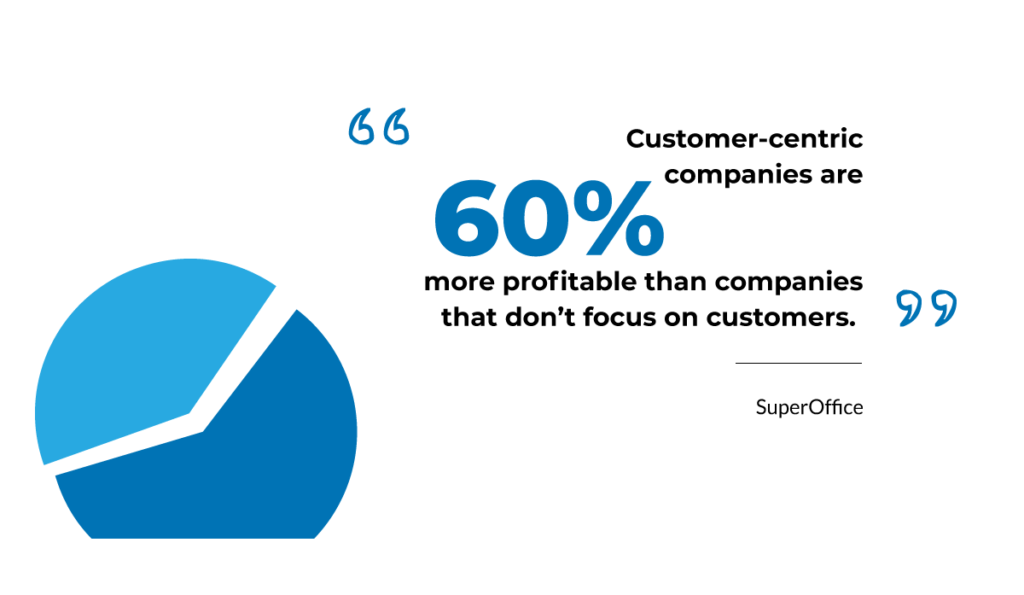
5. How do you collect Customer Feedback?
Now that you’re familiar with the customer feedback loop, let’s delve deeper into the specifics of every stage. On stage 1, the Ask/Survey stage, you need to react to a customer’s action by asking the right questions. There are various feedback collection methods and your choice will need to factor in elements such as the touchpoint, the nature of the audience and the objective that you wish to achieve.
Another important aspect of feedback collection is the question of time. When is the right time to conduct a survey? A general rule to follow goes like this: when you want to ask questions about the purchasing experience, it is advised to activate a survey after a little time has passed since the purchase was completed. If you want to get feedback on more general facets of customer experience and shed light on what your audience thinks of your brand, then you can ask at a later time.

Here is a list of the main feedback collection methods:
- Website Surveys
- Feedback Button
- Email or SMS Surveys
- Chat Surveys
- Market Research Methods
Let’s examine each of them:
1. Website Surveys: Website surveys is a term that encompasses all the different ways that a questionnaire may appear to a customer who is browsing a website. Pop-ups are the most usual form of website surveys.
What are the pros of website surveys?
- They provide real-time feedback which allows you to gauge the actual customer experience and not their perception of the brand.
- The right question can appear at the right time. You can set specific questionnaires to appear on specific points of the customer browsing process. Let’s see some examples:
-
-
- Homepage: What are you looking to do today?
- Product page: Did you find what you’re looking for?
- Product description page: Is there any other information you feel is missing?
- Cart page (exit intent): What is stopping you from proceeding with this purchase?
- Payment page (exit intent): Are you experiencing any payment issues?
- Post-purchase: Rate your purchase experience.
-
- They give you the chance to address an audience already interested in your brand/products directly.
- Pop-up surveys that show up during browsing usually have a good response rate because they correspond to the customer’s interest at that specific moment.
- Optimizing the moment of appearance of website surveys can lead to an even better response rate, as shown by embedded options in the check-out stage.
2. Feedback Button: Feedback collection with this method is usually divided into two stages: first, the user clicks or taps on CTA (Call to Action) button and then is transferred to a page with a questionnaire.
The advantage of the feedback button is that it is a simple and direct way to ask for feedback and it plays on the psychological principle that when one takes initiative to start something it is possible that he/she complete said action.
The disadvantage of this method is its relatively low response rates, but it can prove effective in the cases of questionnaires concerning the website browsing experience or the evaluation of the check out process.
3. Email or SMS/Viber Surveys: Communication via these channels are options that you need to consider in the cases of surveys concerning the evaluation of a purchase, the delivery process or a product/service (after-sales).
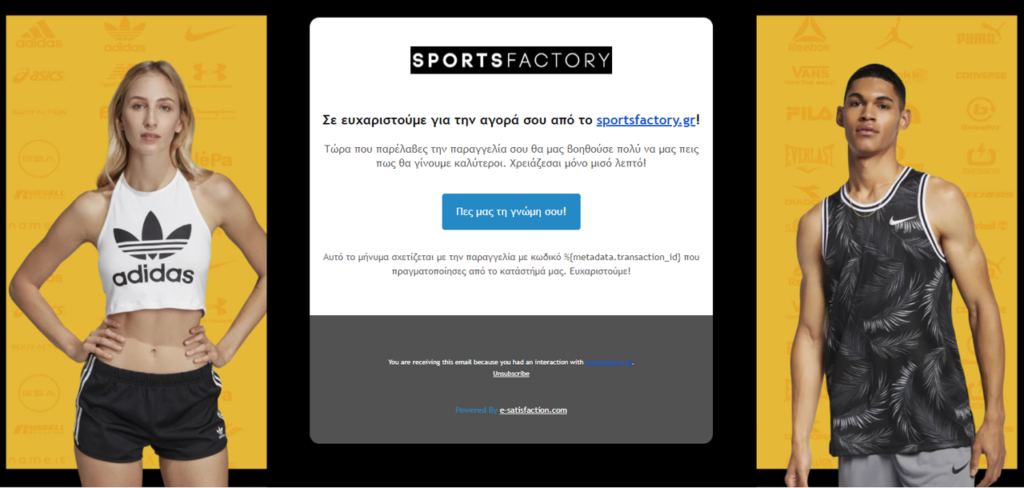
The pros of this method are that it allows you to experiment and see what works best. A catchy subject line, the use of branded elements from your tone of voice to the questionnaire form, the opportunities for personalization are some of the areas that can be optimized and lead to impressive results. Incentives can also be used to get recipients to take part in the surveys, though it should be noted that this is an approach that should not be overused.
The choice between channels (email VS Viber/SMS) depends heavily on a brand’s industry. For example, a mobile phone company would be better suited for strictly mobile channels.
Email or SMS/Viber Surveys have a lower response rate than their website counterparts, although email surveys generally fare betters that the SMS/Viber versions and this is why email surveys should always be optimized for mobile.
4. Chat Surveys: This alternative to pop-ups works well for website browsing and check out stages evaluation. It is a considered a user-friendlier -since it is basically a form of communication between human beings- and less intrusive method of feedback collection. It also facilitates the recording of customers’ personal information, even if the customer has not yet logged in or completed a purchase. Plus, they collect real-time feedback and allow you to try different automations via the employment of chatbots.
Chat surveys’ response rate depends on the duration of the survey and the use of to the point questions that result in more valuable collected information.
5. Market Research Methods: This is a slightly different method compared to the ones mentioned so far. It is more extensive, puts an emphasis on data analysis and requires a deeper probe into customers’ thinking.
Its disadvantage is that it is time-consuming and creates a distance between the customer’s actual experience and the moment he is asked to describe it. If real-time feedback is essential, then this method should be avoided, even if the information that it generates is considered more detailed in comparison to the other alternatives.
6. What are the most important Customer Feedback metrics?
Customer feedback metrics can seem tricky at first glance but they become extremely valuable once you understand the reasoning behind them and learn to activate and measure them.
The three main customer feedback metrics are:
- Net Promoter Score (NPS) aka “the famous one”, since it is the most used metric of the three.
- Customer Satisfaction Score (CSAT) aka “the older one”, since it has been around longer than the others and is also better known.
- Customer Effort Score (CES) aka “the newcomer”, since it was developed fairly recently and has caused numerous debated about each metric’s function.
What is NPS?
NPS is the willingness of consumers to recommend your product to someone they know. Ιt is also a good way to measure your potential Word of Mouth (WoM) and to diagnose if your customers are OK with their choice. Furthermore, NPS is a valid metric to check whether your customers are becoming loyal to the brand/store.
The question set has a simple wording:

NPS is not a % index. It is the result of a logical equation that counts how many customers are willing to recommend the brand/store/company in comparison to those that wouldn’t. The latter customer category is very important since their opinions and feelings may possibly compromise the brand.
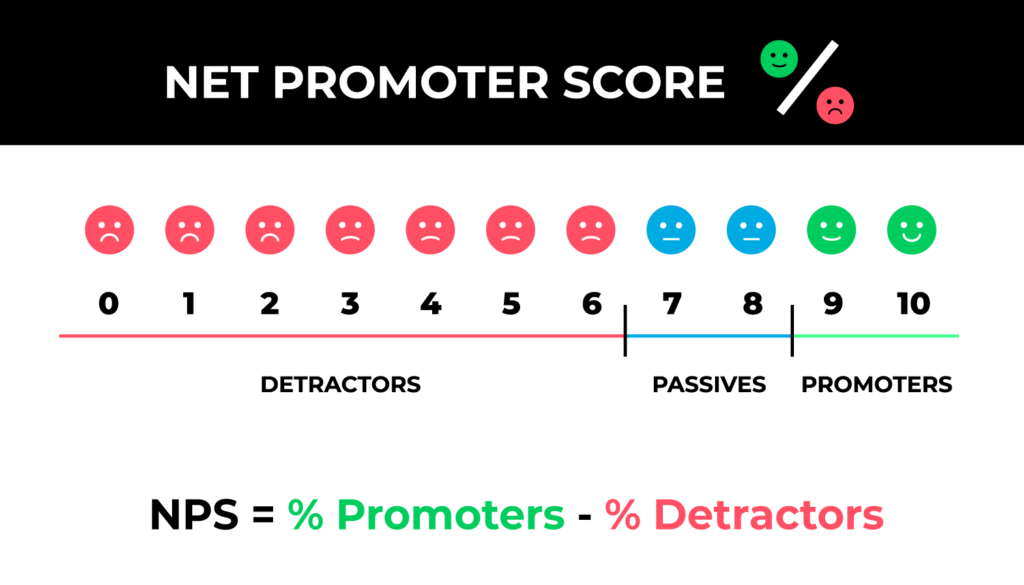
You got 15 minutes? Let our team show you
how we can help your business grow!
There are different NPS benchmarks depending on the industry and they keep changing over the years.
Net Promoter Scores range from -100 to +100, and what is considered ‘good,’ ‘bad,’ or ‘neutral’ can vary greatly across industries. Some count a positive score (i.e. any score over 0) as good, since it shows some customer loyalty and customer satisfaction. But to be more specific, in the e-commerce world a score of 50 or higher is generally considered a very good NPS score.

What is CSAT?
Customer Satisfaction or CSAT is the metric that tracks how satisfied customers are with their experiences with a brand, product or service. It essentially quantifies your audience’s satisfaction level.
The question usually used in CSAT surveys is this:

Variations of this simple question can be also employed depending on the point of interest. Customers can rate a single product or process, but they can also rate their overall impression of the brand. This versatility is what makes CSAT one of the most important metrics in Customer Experience. The question at the heart of this metric may seem simple, but the feedback that it offers is important and multifaceted.
CSAT calculation follows this formula:

A good CSAT score is estimated between 75% and 85%, but benchmarks vary across industries.

What is Customer Effort Score (CES)?
CES is a fairly recent CX metric that, along with NPS (Net Promoter Score) and CSAT (Customer Satisfaction Score), can provide insights on customers’ satisfaction and the quality of their relationship with a brand/store. The question used to measure CES is along the lines of “How easy was it for you to (e.g. complete your transaction)?”

A scale from 1 to 5, 1 to 7 or 1-10 (1 standing for “very difficult” and 5, 7 or 10 for “very easy”) tracks the effort that customers put into a transaction/interaction with a company. Answers between 5 and 7 are considered a good CES, although an industry benchmark has not been set yet.
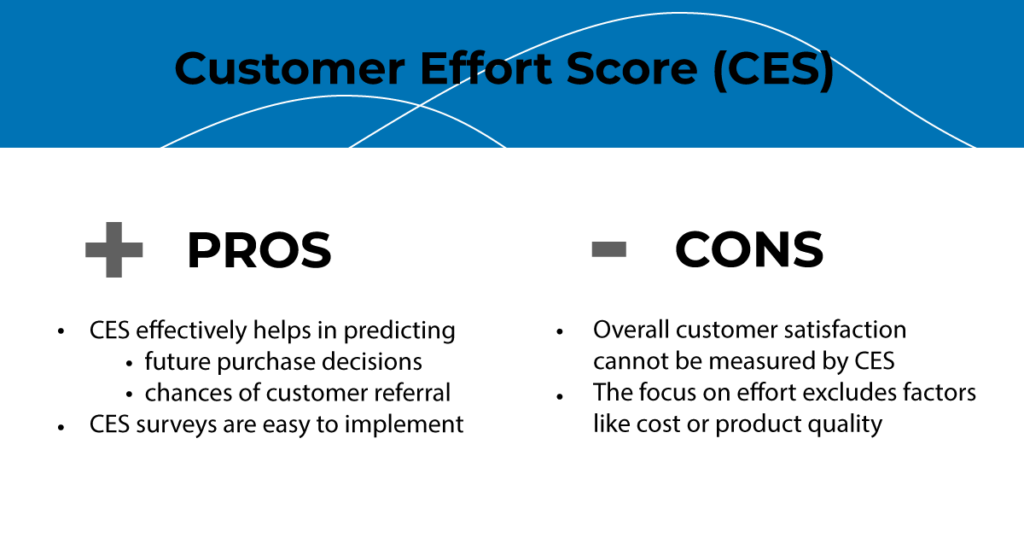
7. How do you use Customer Feedback to your advantage?
You’ve read about its different types and ways to collect and measure it. Now, we are going to delve deeper into the ways that feedback can be used to grow your brand and fuel customer loyalty.
There are numerous reasons why you should invest time and effort to foster loyalty. Until the late ‘00s, e-commerce had been growing in such impressive rates that customer acquisition was the focus for brands and retailers because it sufficed in keeping a company afloat. Customer loyalty is a term that entered the e-commerce discussion during the last decade and it has gradually proven to become both an objective and a necessity for companies. With customer acquisition expected to represent about 3% of growth strategies (an all-time low figure!) around 2025, customer loyalty is becoming more prominent every day.
Thus feedback has emerged as the only way to create engagement and generate customer loyalty!
How can you use customer feedback?
Asking for feedback is the first step in communicating your customers that their opinion matters.
The second step is to make good use of the information on your disposal, distribute it to the customer service, marketing and sales teams and turn it into meaningful actions. This step is what proves to your customers that you don’t ask just for asking’s sake but in order to offer them the best possible experiences.
Here are a number of effective ways to use customer feedback:
a. Use feedback as social proof
The idea of social proof is that someone can be persuaded into trying a product or service simply because they’ve seen a positive review or read an expert quote that is linked to the product. The reason that social proof works is because it adds weight and verification to the arguments companies make about their products.
Product reviews are one form of social proof that adds credibility to a brand through the words of satisfied or even not so pleased customers.

Another form of social proof is the strategic placement of your survey results. If you communicate your CSAT, NPS or CES scores, you create a sense of transparency and show potential customers that you keep up on satisfaction levels.
At e-satisfaction.com, we have come up with an easy way to use scores as social proof with our Customer Experience Badge.
b. Use feedback to enlighten and inspire the sales, marketing and product departments
When it comes to the optimal utilization of collected and analyzed feedback, all parties involved must be on the same page. If you make the effort of recording your customers’ voice, it would simply be a waste if it’s not heard by everyone. Distribute data and insights to team members, who can draw on the findings to come up with strategies and courses of actions that will enhance the consumer-centric nature of your brand, boost engagement and increase loyalty.
c. Use feedback to guide your personalization strategy
Personalization, the practice of using data to create and offer tailor-made experiences to customers, is all the rage and a range of automation tools is available to easily set up and execute personalized campaigns for all customer touchpoints. If executed properly, these automations contribute to lead generation, higher conversions and increased revenue.
Taking into account their sentiment and evaluation, you can create the appropriate communication flows that include content that is targeted to the needs of each customer segment.
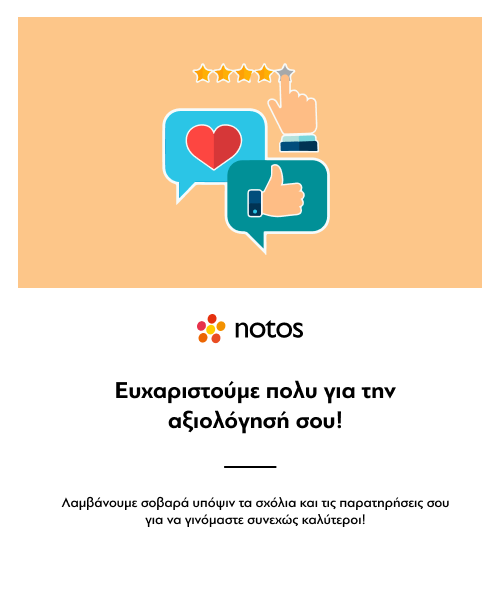
A simple example of personalization is the creation of thank you pages that correspond to the actions of a user. Do not focus only on data like gender, age or other demographics, but on what the customers have to say about their experience.

This broader type of personalization indicates empathy, understanding, a will to be helpful and it can sometimes have preventive qualities or help you tone down a crisis.
d. Use feedback to diagnose and solve problems
There is no one better at detecting bottlenecks than the actual users of a website, product or service. Thus, their feedback is valuable when you need to pinpoint the areas in need of improvement and streamline processes that will result in a user-friendly website that facilitates lead generation and boost conversions.
But it’s not just the UX and IT teams that can greatly benefit from having access to feedback. Support and after sales teams -the people who have a direct line of communication with customers- will be able to better handle them, prepare in the event of a crisis and set up instructions and procedures that can make them more efficient.
